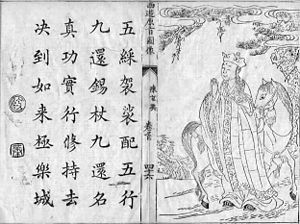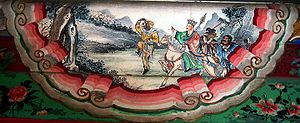.gif)
Xuanzang (fictional character)
Encyclopedia


The fictional character Xuanzang is a central character of the classic Chinese
Chinese literature
Chinese literature extends thousands of years, from the earliest recorded dynastic court archives to the mature fictional novels that arose during the Ming Dynasty to entertain the masses of literate Chinese...
novel
Novel
A novel is a book of long narrative in literary prose. The genre has historical roots both in the fields of the medieval and early modern romance and in the tradition of the novella. The latter supplied the present generic term in the late 18th century....
Journey to the West
Journey to the West
Journey to the West is one of the Four Great Classical Novels of Chinese literature. It was written by Wu Cheng'en in the 16th century. In English-speaking countries, the tale is also often known simply as Monkey. This was one title used for a popular, abridged translation by Arthur Waley...
.
For most of the novel he is known as Táng
Tang Dynasty
The Tang Dynasty was an imperial dynasty of China preceded by the Sui Dynasty and followed by the Five Dynasties and Ten Kingdoms Period. It was founded by the Li family, who seized power during the decline and collapse of the Sui Empire...
-sānzàng, the title Sānzàng (三藏 "three collections") referring to his mission to seek the Sānzàngjīng, the "Three Collections of (Buddhist) Scriptures". In some English
English language
English is a West Germanic language that arose in the Anglo-Saxon kingdoms of England and spread into what was to become south-east Scotland under the influence of the Anglian medieval kingdom of Northumbria...
translations, the title is rendered as Tripitaka
Tripiṭaka
' is a traditional term used by various Buddhist sects to describe their various canons of scriptures. As the name suggests, a traditionally contains three "baskets" of teachings: a , a and an .-The three categories:Tripitaka is the three main categories of texts that make up the...
(tripitaka, Sanskrit
Sanskrit
Sanskrit , is a historical Indo-Aryan language and the primary liturgical language of Hinduism, Jainism and Buddhism.Buddhism: besides Pali, see Buddhist Hybrid Sanskrit Today, it is listed as one of the 22 scheduled languages of India and is an official language of the state of Uttarakhand...
; Devanagari
Devanagari
Devanagari |deva]]" and "nāgarī" ), also called Nagari , is an abugida alphabet of India and Nepal...
: त्रिपिटक is the original Sanskrit
Sanskrit
Sanskrit , is a historical Indo-Aryan language and the primary liturgical language of Hinduism, Jainism and Buddhism.Buddhism: besides Pali, see Buddhist Hybrid Sanskrit Today, it is listed as one of the 22 scheduled languages of India and is an official language of the state of Uttarakhand...
term for the Sānzàngjīng). He is also commonly referred to as Táng-sēng (唐僧 "Tang-monk"), which is a courtesy name that, like the former name, reflects his status as the adopted "brother" of the Tang
Tang Dynasty
The Tang Dynasty was an imperial dynasty of China preceded by the Sui Dynasty and followed by the Five Dynasties and Ten Kingdoms Period. It was founded by the Li family, who seized power during the decline and collapse of the Sui Empire...
emperor, Taizong
Taizong
Taizong may refer to:*Emperor Taizong of Tang , Chinese emperor of the Tang Dynasty*Emperor Daizong of Tang , Chinese emperor of the Tang Dynasty...
. As "Tripitaka" he is a leading character in the cult Japan
Japan
Japan is an island nation in East Asia. Located in the Pacific Ocean, it lies to the east of the Sea of Japan, China, North Korea, South Korea and Russia, stretching from the Sea of Okhotsk in the north to the East China Sea and Taiwan in the south...
ese Television series Monkey
Monkey (TV series)
Monkey is the dubbed English language version of the Japanese television series , based on the classic sixteenth century Chinese novel Journey to the West by Wu Cheng'en. It was originally produced by Nippon Television and International Television Films in association with NHK.The series ran for...
.
Character
In the story, he is constantly terrorized by monsters and demons because of a legend that they would obtain immortality by eating the flesh of a holy man. While he is a pacifist who has no fighting ability of his own, he is flanked by his three powerful disciples - Sun WukongSun Wukong
Sun Wukong , also known as the Monkey King is a main character in the classical Chinese epic novel Journey to the West . In the novel, he is a monkey born from a stone who acquires supernatural powers through Taoist practices...
, Zhu Bajie
Zhu Bajie
Zhu Bajie, also named Zhu Wuneng, is one of the three helpers of Xuanzang in the classic Chinese novel Journey to the West. He is called "Pigsy" or "Pig" in many English versions of the story....
, and Sha Wujing
Sha Wujing
Shā Wùjìng is one of the three disciples of Xuánzàng in the classic Chinese novel Journey to the West, although versions of his character predate the Ming novel. In the novels, his background is the least developed of the pilgrims and he contributes the least to their efforts...
- themselves "monsters" who have vowed to protect him on his journey in order to atone for their sins in Heaven; while the heavenly origins of Wukong are up for debate, both Bajie and Wujing (and even the horse on which Xuanzang rides) were once minor deities in Heaven who were cast to Earth for their wrongdoings.
Historical background
Xuanzang is modeled after the historical Tang DynastyTang Dynasty
The Tang Dynasty was an imperial dynasty of China preceded by the Sui Dynasty and followed by the Five Dynasties and Ten Kingdoms Period. It was founded by the Li family, who seized power during the decline and collapse of the Sui Empire...
Buddhist monk of the same name
Xuanzang
Xuanzang was a famous Chinese Buddhist monk, scholar, traveler, and translator who described the interaction between China and India in the early Tang period...
, whose life was the book's inspiration; the real Xuanzang made a perilous journey on foot from China
China
Chinese civilization may refer to:* China for more general discussion of the country.* Chinese culture* Greater China, the transnational community of ethnic Chinese.* History of China* Sinosphere, the area historically affected by Chinese culture...
to India
History of India
The history of India begins with evidence of human activity of Homo sapiens as long as 75,000 years ago, or with earlier hominids including Homo erectus from about 500,000 years ago. The Indus Valley Civilization, which spread and flourished in the northwestern part of the Indian subcontinent from...
(and back again) to obtain Buddhist sutra
Sutra
Sūtra is an aphorism or a collection of such aphorisms in the form of a manual. Literally it means a thread or line that holds things together and is derived from the verbal root siv-, meaning to sew , as does the medical term...
s.
In contrast to the real Xuanzang, who was a wise and learned scholar (he was in his late 20s when he left for India), Xuanzang is presented as a young boy monk who is extremely naive, showing idealistic compassion without wisdom. Xuanzang is usually quick to fall for the facades of demons who have disguised themselves as innocent humans, whereas Sun Wukong can see through them with his magic powers (specifically a special sort of eyesight that sees through the said disguises). This frequently leads to tension when Sun Wukong attacks and kills apparently innocent humans when the demon has in fact simply abandoned the dead corpse and run away. One such popular instance was when the White Bone Demon
Bai Gu Jing
Bai Gu Jing is a yaoguai from Journey to the West.-Plot:The four travelers have entered another dangerous region. Sun Wukong leaves to scout around the area, but puts Sanzang and the other two disciples inside a magic circle...
(白骨夫人, Chinese: Bai Gu Fu Ren) disguised three times as family members—first, a young woman. After Wukong "killed" the woman, the demon escaped, but Wukong was punished by Xuanzang for it. The second was the young woman's elderly mother, looking for her daughter. The third was the young woman's elderly father, searching for his wife and child. Upon the "death" of the father by Wukong's hands, Wukong finally killed the demon before she got away. Xuanzang, convinced that Wukong had actually killed three family members, sent him away, despite protests. Xuanzang usually punishes him by chanting the words of the headache spell (緊箍咒) given to Xuanzang by Guanyin to control Wukong, which causes the latter's headband to contract and give him acute headaches.
As Sun Wukong is often worshiped as a protector god, so is Xuanzang. Also, Ksitigarbha
Ksitigarbha
Ksitigarbha is a bodhisattva primarily revered in East Asian Buddhism, usually depicted as a Buddhist monk in the Orient. The name may be translated as "Earth Treasury", "Earth Store", "Earth Matrix", or "Earth Womb"...
, a bodhisattva
Bodhisattva
In Buddhism, a bodhisattva is either an enlightened existence or an enlightenment-being or, given the variant Sanskrit spelling satva rather than sattva, "heroic-minded one for enlightenment ." The Pali term has sometimes been translated as "wisdom-being," although in modern publications, and...
in Buddhism, is occasionally mistaken for Xuanzang due the fact that Ksitigarbha is often portrayed like Xuanzang, with the robes, crown and staff of a monk.
Modern references
Xuanzang appears in the Koei hack-n-slash video game's Warriors Orochi 2Warriors Orochi 2
is a video game developed by Koei and Omega Force for the Sony PlayStation 2. It is the sequel to Warriors Orochi, a crossover video game of the Dynasty Warriors and Samurai Warriors series. The game was released on September 23 in North America and September 19 in Europe...
and Warriors Orochi Z
Warriors Orochi Z
, is a hack and slash video game developed by Koei and Omega Force for the Sony PlayStation 3 and Microsoft Windows. Z' is the third installment of the Warriors Orochi series, a crossover video game of the Dynasty Warriors and Samurai Warriors series...
, but appears as the female
Female
Female is the sex of an organism, or a part of an organism, which produces non-mobile ova .- Defining characteristics :The ova are defined as the larger gametes in a heterogamous reproduction system, while the smaller, usually motile gamete, the spermatozoon, is produced by the male...
sex instead of the male
Male
Male refers to the biological sex of an organism, or part of an organism, which produces small mobile gametes, called spermatozoa. Each spermatozoon can fuse with a larger female gamete or ovum, in the process of fertilization...
sex.
In the two games, her name is Sanzang or San Zang. In the Warriors Orochi 2 Story Mode, she appears in the Wu
Wu
Wu may refer to:Places:* Wu , a region in China, associated with:** Wu Chinese, a variety of spoken Chinese spoken in the Wu region** Wu , a state in the Wu region during the Spring and Autumn Period...
story, aiding Wu and it's allies to stop the resurrection of Orochi
Orochi
or Orochi, translated as the Eight-Forked Serpent in English, is a legendary 8-headed and 8-tailed Japanese dragon that was slain by the Shinto storm-god Susanoo.-Mythology:...
. In Dream Mode of Warriors Orochi 2, Sanzang is pursuing Sun Wukong, who also appears in the game, seeking to take Wukong home, but keeps accidentally allowing Wukong to escape, as Wukong says, "Good thing I'm faster than you my lady!"
The character of Trip, a technically savvy teenage girl, in the video game Enslaved: Odyssey to the West, is inspired by Xuanzang.

